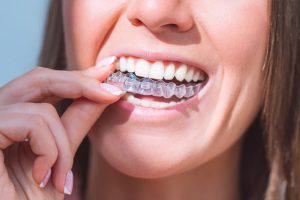When your child comes in for early orthodontic treatment, it’s usually not just because their teeth are not aligned. Because of this misalignment, this can lead to poor facial development or other health problems. If your child’s developing jaws and face don’t grow correctly, there may be health issues that affect their sleep quality and consequently impact healthy brain and body development.
Tooth eruption is yet another issue, but our orthodontist can monitor and guide your child’s teeth to fix problems early on. This is also why the American Association of Orthodontists® advises that your child has their first orthodontic screening by the age of seven to assess their need for orthodontic treatment. The goal is to begin treatment early to fix issues before they grow into more costly and time-intensive concerns.
Treating your child’s dental issues earlier can help create the room needed for erupting teeth that are crowded, allow space for the teeth that are yet to erupt, lessen the need for tooth extractions, and guide their jaw growth for facial symmetry. If your child snores or breathes through the mouth, wakes up frequently, grinds their teeth, wets the bed, or has trouble falling asleep, orthodontic treatment can even help with these problems. Other issues that can be resolved with orthodontics are speech impediments, chronic headaches, colds, sore throats, or ear infections.
If baby teeth are lost too soon or too late, this may lead to crowding of the permanent teeth. Your child’s smile or bite can also be affected by thumb-sucking. A crossbite can also influence your child’s teeth and lead to gum disease, and chronic pain in the jaw, neck, and shoulder areas. This can even affect your child’s self-confidence leading to behavioral issues.
Early orthodontic treatment is done in two stages, Phase I and II. This allows your child’s permanent teeth to come in correctly and help prevent extractions down the road. Phase I is generally done around the age of eight or nine, while Phase II is done around age 11 to 15.
Phase I focuses on helping your child learn good oral hygiene habits, resolving dental issues, and correcting their bite and jaw development while shifting their permanent teeth into the proper place. The goal of this phase is to start improving your child’s alignment and lessen the risk of dental issues in the future.
In Phase II, braces are employed to guide your child’s permanent teeth into position and stabilize them. Having orthodontic treatment done at this age can prevent the need for braces as an adult (which often involves tooth extraction or oral surgery), so wearing braces as a child prevents this and reduces the length of time they need to wear braces.
If you would like to have your child’s oral development checked, our orthodontist is happy to determine whether treatment is needed and design a personalized treatment plan for the best results. If you would like to find out more or want to schedule your child’s orthodontic consultation with us, please call or visit us today!







